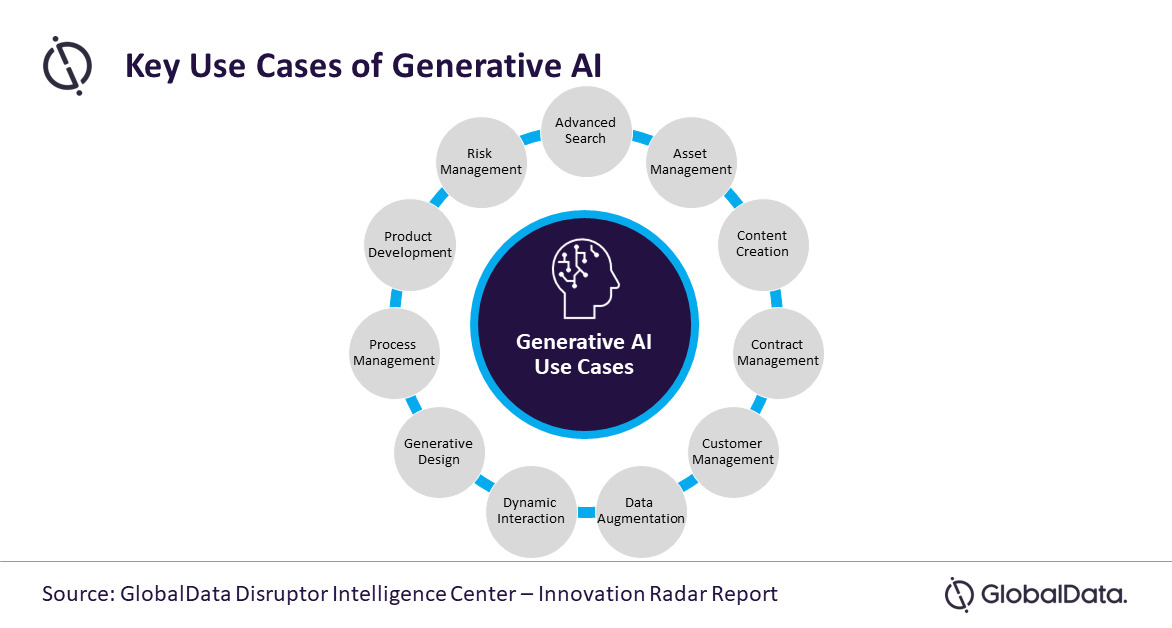
While the tech world is abuzz with ChatGPT, its underlying technology i.e., generative AI has capabilities that go beyond simple chatbots with normal query-answering features to write essays, debug codes, and explain complex topics. The technology gains investor attention to find new applications such as data augmentation, product development, and risk management across sectors, finds GlobalData.
Kiran Raj, Practice Head of Disruptive Tech at GlobalData, comments: “Generative AI has expanded beyond the conventional use of AI for tasks such as malware detection, recommendation engines, and forecasting models to create new content such as text, code, image, simulations, and video based on the user text input (text-to-x), opening up a broad spectrum of use cases across various industries.”
Saurabh Daga, Associate Project Manager of Disruptive Tech at GlobalData, comments: “The generative AI space is witnessing a two-pronged growth: on one hand, we see an evolving application landscape across sectors, and on the other hand a continuous improvement in AI models with a shift towards multimodality. For instance, OpenAI’s recently released generative pre-trained transformer 4 (GPT-4) goes beyond its predecessor GPT-3.5 to accept images as a part of the input prompt.”
GlobalData’s latest Innovation Radar report, “Text-to-X: how ChatGPT and generative AI can transform the future of business,” highlights the recent developments on how generative AI can be a transformational technology for enterprises with key use cases such as advanced search, content generation, customer management, and data augmentation.

Sector: Technology | Use Case: Advanced Search | Application: Text-to-Text
Microsoft announced a major upgrade to its existing search and browser capabilities with the launch of the generative AI-augmented Bing search engine and Edge browser in February 2023. These tools are based on OpenAI’s generative pre-trained transformer (GPT)-3.5 and can create content and engage in conversational search and browsing experiences.
Foodservice | Content Generation | Text-to-Image
Lunchbox, a US-based restaurant tech startup, collaborated with generative AI startup OpenAI in February 2023 to develop an AI-powered food photo creator DALL-E 2 to create menu photos that could convince customers to order more. OpenAI’s DALL-E text-to-image technology is aimed at restaurants that need to quickly create images of food for their social media pages, websites, and menus.
Healthcare | Product Development | Text-to-Design
NVIDIA collaborated with biotech startup Evozyne in January 2023 to develop a generative AI model named Protein Transformer Variational AutoEncoder (ProT-VAE) to accelerate drug development. The model aids the pharmaceutical industry to design therapeutic proteins.
Automotive | Dynamic Interaction | Text-to-Voice
SoundHound AI, a US-based audio and speech recognition company, unveiled a voice assistant platform ‘Dynamic Interaction’ for the automotive industry in February 2023. The platform combines third-party generative AI OpenAI’s ChatGPT with SoundHound’s real-time, multimodal interface and proprietary AI. The platform allows users to access knowledge, information, and search capabilities.
Daga concludes: “The growing interest in generative AI has caught the attention of technology regulators, who want to curb its potential misuse. Enterprises should also be mindful of several potential drawbacks associated with the use of this technology. Although generative AI can offer useful content, it is an energy-intensive technology and not suited for tasks that require understanding, planning, and problem-solving. Moreover, it suffers from the inherent biases in the models it is trained on. Nevertheless, proper governance and regulatory mechanisms can ensure that the potential of generative AI technologies is realized fully.”






